Written by: Reva Grewal
An ecosystem consists of a delicate balance of interactions between all organisms in their physical environment (Randerson, 2008). This balance is vital for the maintenance of populations within an ecosystem over time. However, some factors can be introduced into an ecosystem that can destroy that balance. Examples include deforestation, habitat removal, and overcrowding. That lends itself to the topic of this blog: invasive species, more specifically invasive species located in Southern Ontario. According to the National Ocean Service, an invasive species is an “organism that causes ecological or economic harm in a new environment where it is not native” (National Ocean Service, 2019). This definition is not just applicable to oceanic creatures but land-dwelling creatures in Southern Ontario as well. This post will detail the invasive species and how to recognize and dispose of them (if necessary). This blog will focus on invasive species that are harmful to plant life.
European Gypsy Moth (Lymantria dispar dispar)
To start, the European Gypsy Moth (Lymantria dispar dispar) caterpillar will be examined, which has been circulating the news as of June 2021. The Gypsy Moth caterpillar has a nasty habit of destroying local trees, with no particular preference as to what kind. This Moth has been found to destroy birch, oak, aspen, sugar maples, american beech, softwood trees, and much more. You may be wondering, why has the infestation not been consistently occurring? The only answer would be that Gypsy Moth outbreaks happen every 7-10 years (periodically). Eggs are laid upon trees in July and the Gypsy Moth larvae devour trees and shrubs. The Gypsy Moth Adult itself is not destroying hordes of trees without discretion, but the caterpillar and larvae are, as evidence by the swarms of larvae and caterpillars that can be found on infested trees (Government of Ontario, n.d). The caterpillar can be described as “fuzzy” with reddish bands on a brown or black body.
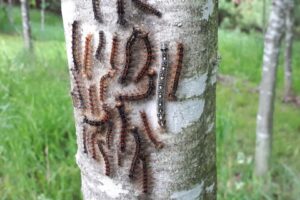
Gypsy Moth Caterpillar (Hawke, 2020)
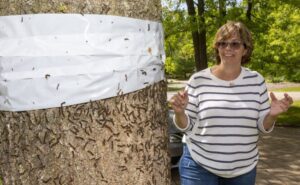
Burlap on the tree (Hensen, 2020)
To get rid of these creatures, the Government of Ontario has a few recommendations, the webpages are linked below if you want to learn more. With egg masses, you want to use don gloves or an object such as a scrapper or swatter. If early-stage caterpillars are on the tree, applying biological pesticides is strongly recommended. To isolate the caterpillars from destroying the rest of the tree, a burlap sack should be applied above the area they are infesting. From there, scrape the Gypsy moth caterpillars/larvae by using a stick (preferably) into a bucket of soapy water (Decaire, 2021).
Some may use the carcasses of both pupae and caterpillars to fertilize gardens or to dispose of them on the ground. You don’t need to worry about adult moths, as they do not live long and do not destroy trees (Government of Ontario, n.d).
Purple Loosestrife (Lythrum salicaria)
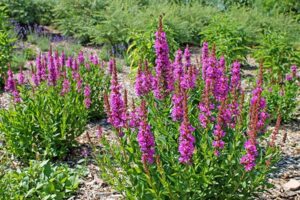
Purple Loosestrife (Environmental Education for Kids, n.d)
The Purple Loosestrife is a plant that grows in Southern Ontario but originates from Europe and Asia. Although it is a seemingly innocuous and beautiful plant, it is invasive. The issue with this particular plant is that it forms thick, dense, mats of roots where it resides. This impacts other plants as it “crowds them out”, meaning it prevents other native plants from acquiring adequate nutrients, oxygen, and sun (Ontario’s Invading Species Awareness Program, n.d). This plant has also been known to clog irrigation canals and pollute pastures that are used for farming or raising livestock (Government of Ontario, n.d). Other provinces also suffer from this plant as its widespread reign spans essentially across all Canadian provinces and some parts of the United States. It also spreads quickly, producing almost 2 million seeds (Invasive Species Centre, 2020). The Government of Ontario has already found ways to reduce the population of this plant by releasing European leaf-eating beetles. This reduced the Purple Loosestrife population by 90% (Government of Ontario, n.d). The easiest way to identify this plant is through its gorgeous purple flowers. It is quite a tall plant, about 1.5-8 feet tall and has many stems spanning from one singular stem. The flowers itself have a spike pattern with thick roots (Lym, 2018).
If you have this plant in your garden, it must be removed. The best time to remove this plant is in the summer months (June, July, and August). Cut flower stalks to prevent further seed spread. Dispose of the plants in plastic bags (DO NOT COMPOST; it may spread more seeds). If you are on a walk and happen to spot the Purple Loosestrife, stay away from it; you do not want to accidentally spread its seeds (Invasive Species Centre, 2020).
Emerald Ash Borer (Agrilus planipennis)
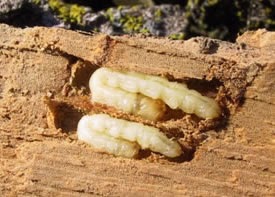
Emerald Ash Borer Larvae (Government of Ontario, n.d)
The Emerald Ash Borer is a shiny beetle that eats trees and lays its eggs in crevices within trees. They mainly choose to infest different types of Ash Trees in Southern Ontario such as the: “Green ash, white ash, black ash, pumpkin ash and blue ash” (Government of Ontario, n.d). The female will lay about 60-90 eggs in a crevice at a time. The larvae consist of a brown and white colour and are also destructive. The signature “D-shape holes” used by the Emerald Ash Borer to exit the trees are clear indicators of tree damage. Infected trees will have foliage wilting and turning yellow (Government of Ontario, n.d). Below are images of both the Emerald Ash Borer (quite aptly named) and its larvae.
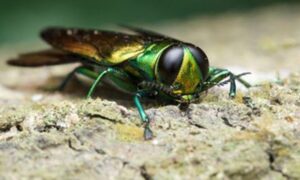
Emerald Ash Borer Adult (Burlington Post, 2016)
Unfortunately, it is very difficult to get rid of this critter. The recommended treatment is to inject the infected trees with insecticides whether through the surrounding soil or by spraying the surface (it is strongly recommended that this is done by professionals). Professionals will arrive bi-annually to inject the tree with insecticides as necessary. If the tree has lost more than half its leaves, then it should be removed permanently (as insects may resurface again). The wood can then be used as firewood (burned) or given to a tree removal surface to turn into mulch (Martins Tree, 2020).
To summarise, invasive species are species that cause great environmental harm to an environment that is not native to it. The Emerald Ash Borer, Purple Loosestrife, and Gypsy Moth caterpillar are all harmful invasive species to plant life in Southern Ontario. If they are found in your garden it is strongly recommended that you dispose of them. The Gypsy Moth caterpillar can be removed with soapy water, the Purple Loosestrife can be removed by hand, and the Emerald Ash Borer can be removed using professional services.
References
Burlington Post. (2016). Beware the emerald ash borer: What to look for. https://www.insidehalton.com/shopping-story/6714649-beware-the-emerald-ash-borer-what-to-look-for/.
Decaire, C. (2021, June 24). Volunteers scramble to save trees from gypsy moth caterpillars | CBC News. CBCnews. https://www.cbc.ca/news/canada/ottawa/gypsy-moth-caterpillar-trees-hampton-park-1.6076698.
Environmental Education for Kids. (n.d.). Alias (scientific name in latin):Lythrum salicaria. https://www.eekwi.org/plants/purple-loosestrife.
Government of Canada. (2020). Prepupae of emerald ash borer. This is the stage in which most of the population overwinters in southern Ontario. https://www.nrcan.gc.ca/forests/fire-insects-disturbances/top-insects/13395.
Government of Ontario. (n.d.). Emerald ash borer. Ontario.ca. https://www.ontario.ca/page/emerald-ash-borer.
Government of Ontario. (n.d.). Gypsy moth. Ontario.ca. https://www.ontario.ca/page/gypsy-moth.
Government of Ontario. (n.d.). Purple loosestrife. Ontario.ca. https://www.ontario.ca/page/purple-loosestrife.
Hawke, D. (2020). This cluster of gypsy moth caterpillars is just chillin’ in the sun until dusk, when they will climb back into the forest canopy. A lone forest tent caterpillar has joined the group. . OrillaMatters. https://www.orilliamatters.com/outdoors/unfortunately-its-a-banner-year-for-gypsy-moth-caterpillars-2447333.
Hensen, M. (2020). Ruth Allan of Port Franks is seriously creeped out by the thousands upon thousands of gypsy moth caterpillars which have enveloped the Lake Huron beach community northwest of London as part of the insect’s regular pattern of a surge in population every six or seven years. The London Free Press. https://lfpress.com/news/local-news/to-add-to-2020-woes-its-the-year-of-the-gypsy-moth-horde.
Invasive Species Centre. (2020, September 24). Purple Loosestrife – Profile and Resources: Purple Loosestrife. Invasive Species Centre. https://www.invasivespeciescentre.ca/invasive-species/meet-the-species/invasive-plants/purple-loosestrife/.
Lym, R. G. (2018, April). IDENTIFICATION and CONTROL of Purple Loosestrife. IDENTIFICATION and CONTROL of Purple Loosestrife (Lythrum salicaria L.) – Publications. https://www.ag.ndsu.edu/publications/crops/identification-and-control-of-purple-loosestrife-lythrum-salicaria-l.
Martins Tree. (2020, January 22). Getting Rid of the Emerald Ash Borer: Cut or Treat? MARTIN’S TREE SERVICE INC. https://www.martinstree.com/blog/getting-rid-of-the-emerald-ash-borer/.
National Ocean Service. (2019, April 2). What is an invasive species? NOAA’s National Ocean Service. https://oceanservice.noaa.gov/facts/invasive.html.
Ontario’s Invading Species Awareness Program. (n.d.). Purple Loosestrife. http://www.invadingspecies.com/invaders/plants/purple-loosestrife/#:~:text=Impacts%20of%20Purple%20Loosestrife&text=By%20crowding%20out%20native%20plants,the%20forage%20value%20of%20pastures.
Randerson, J. (2008, April 26). A delicate balance. The Guardian. https://www.theguardian.com/science/2008/apr/27/genetics.plants.

